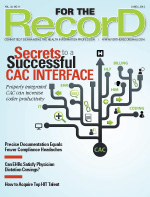 June 4, 2012
June 4, 2012
Coding for ‘Summertime Blues’
For The Record
Vol. 24 No. 11 P. 28
Coding for Lyme Disease
Lyme disease is a tick-borne bacterial disease characterized by a distinctive rash, flulike symptoms, and aching joints. A person can contract the disease when bitten by a deer tick infected with the spiral-shaped bacterium Borrelia burgdorferi. If the tick remains attached to the person for more than 48 hours, the bacterium passes into the person’s bloodstream; however, prompt removal of the tick may prevent infection. Also, not all ticks carry the bacterium, and not all infected tick bites cause Lyme disease.
The signs and symptoms of Lyme disease vary greatly and may involve more than one body system, such as the skin, joints, and nervous system. Common signs and symptoms include a bull’s-eye rash at the site of the tick bite; flulike symptoms such as fever, chills, fatigue, body aches, and headache; migratory joint pain that may develop a few months after the initial tick bite if the infection is not treated; and, in severe cases, neurological problems such as meningitis, Bell’s palsy, numbness or weakness in extremities, and impaired muscle movement.
Lyme disease is classified to ICD-9-CM code 088.81. In severe cases, other conditions may be associated with the Lyme disease. Sequence code 088.81 first followed by the code for the associated condition, such as the following:
• arthritis: 088.81 + 711.8x (The fifth-digit code assignment depends on the site of the arthritis.);
• cardiomyopathy: 088.81 + 425.8;
• encephalitis: 088.81 + 323.41;
• meningoencephalitis/meningitis: 088.81 + 320.7;
• myelitis: 088.81 + 323.42; and
• myocarditis: 088.81 + 422.0.
When coding the late effects of Lyme disease, sequence the late-effect code (139.8) first. “If the patient has been cured of Lyme disease, but still suffers from a residual (chronic) condition, code as a late effect” (AHA Coding Clinic for ICD-9-CM, 1991, fourth quarter, pages 14-16). If there is insufficient information in the medical record to identify late Lyme disease or a late effect of Lyme disease, ask the physician for clarification. The length of time between the initial diagnosis of Lyme disease and the current symptoms is not enough evidence to determine if the Lyme disease is current or a late effect/sequela.
Coding for Poison Ivy
Poison ivy, as well as poison oak and poison sumac, are types of allergic contact dermatitis that may cause a skin rash. Allergic contact dermatitis is caused by exposure to a material to which the person has become hypersensitive. Typically, the person will not have a reaction the first time he or she is exposed to the substance. However, repeated exposure may cause sensitivity to the allergen and therefore cause a reaction with subsequent exposure. Code 692.6, Contact dermatitis/eczema due to plants, is assigned for poison ivy, oak, or sumac. The symptoms of rash include itchy skin at the point of contact, red streaks/lines or general redness, small bumps or hives, and fluid-filled blisters.
Typically the rash occurs eight to 48 hours after the contact. However, it may occur as early as five hours or as late as five days after exposure to the plant.
Coding for Sunburn
A sunburn occurs after a few hours of exposure to the sun and causes red, painful skin that is warm to the touch. The common signs and symptoms of sunburn include pinkness or redness, warm to hot skin, pain and tenderness, swelling, fluid-filled blisters, headache, fever, and fatigue.
Code assignment for sunburn depends on the degree of burn as follows:
• 692.71, First-degree sunburn;
• 692.76, Second-degree sunburn; and
• 692.77, Third-degree sunburn.
Sunburn of unspecified degree is classified to code 692.71. A burn from UV rays other than the sun, such as a tanning bed, is classified to code 692.82. Code 692.82 also includes infrared rays; light, except from the sun; radiation not otherwise specified; and X-rays.
Coding and sequencing for Lyme disease, poison ivy, and sunburn are dependent on the physician documentation in the medical record and application of the Official Coding Guidelines for inpatient care. Also, use specific AHA Coding Clinic for ICD-9-CM and American Medical Association CPT Assistant references to ensure complete and accurate coding.
— This information was prepared by Audrey Howard, RHIA, of 3M Consulting Services. 3M Consulting Services is a business of 3M Health Information Systems, a supplier of coding and classification systems to more than 5,000 healthcare providers. The company and its representatives do not assume any responsibility for reimbursement decisions or claims denials made by providers or payers as the result of the misuse of this coding information. More information about 3M Health Information Systems is available at www.3mhis.com or by calling 800-367-2447.
ICD-10-CM Coding for ‘Summertime Blues’
In ICD-10-CM, combination codes are available for Lyme disease. Therefore, only one code may be necessary to identify the Lyme disease and the associated condition. Lyme disease is classified to code A69.2. A fifth character is needed to identify the commonly associated conditions such as follows:
• A69.20, Lyme disease, unspecified;
• A69.21, Meningitis due to Lyme disease;
• A69.22, Other neurologic disorders in Lyme disease (applicable to Cranial neuritis, Meningoencephalitis, Polyneuropathy);
• A69.23, Arthritis due to Lyme disease; and
• A69.29, Other conditions associated with Lyme disease (applicable to Myopericarditis due to Lyme disease).
Code L23.7, Allergic contact dermatitis due to plants, except food, is assigned to identify poison ivy, oak, and sumac.
Sunburn is classified to category L55 in ICD-10-CM. Similar to ICD-9-CM, a fourth character will identify the degree in ICD-10-CM as follows:
• L55.0, Sunburn of first degree;
• L55.1, Sunburn of second degree;
• L55.2, Sunburn of third degree; and
• L55.9, Sunburn, unspecified.



